Animal husbandry and dairying have been part of human life since the start of civilisation. They have contributed not only in providing low-cost and nutritious food to millions of people; but also in providing animal power and maintaining ecological balance. There exists a close link between livestock production and agriculture. The sector supports agriculture by providing critical inputs, and can supplement incomes of even those who are engaged primarily in other occupations.
Contribution to National and State Economy
Livestock sector is an important sub-sector of the agricultural sector of the economy. The share of agriculture (including crops, forestry, livestock and fishing) has declined in total gross value added (GVA) of the country since 2011-12, but the share of livestock has remained constant at 4 per cent. Moreover, the share of livestock sector in the GVA of agriculture Sector (at constant prices) has increased from 21.8 per cent in 2011-12 to 25.7 per cent in 2015-16.
In Kerala, the share of livestock in Gross State Value Added (GSVA) from Agriculture Sector is nearly 29 per cent. However, it has shown a marginal fall from 29.35 per cent in 2015-16 to 29.14 per cent in 2016-17. Though GSVA from the sector has increased in absolute numbers, its share in total GSVA of the State has also declined marginally from 3.18 per cent in 2015-16 to 3.08 per cent in 2016-17.
Livestock Population
As per 19th Livestock Census (2012), the livestock population of the country is 512 million which includes 299.61 million bovines, 65.07 million sheep, 135.2 million goats and about 10.3 million pigs. Compared to the last 18th Livestock Census (2007), when the livestock population of the country was 529 million, the total livestock population of the country showed a marginal decline. However, the number of buffaloes has registered slight increase. The population of poultry has shown an increase of more than 12 per cent from about 649 million (18th Livestock Census, 2007) to 729 million (19th Livestock Census, 2012).
As per the 19th Livestock census (2012), the livestock population in the State is 27.35 lakh. It is 23 per cent less as compared to previous census. The primary reason for this is the decline in the population of cattle and goats (which form the majority share) by 23.62 per cent and 27.9 per cent respectively. Amongst the cattle, 12.51 lakh (94 per cent) are cross bred and only 77 thousand are indigenous, the indigenous breed recording decline of 35.18 per cent as compared to the previous census. The poultry population of Kerala as per 19th Livestock census (2012) is 242.82 lakh, which accounts for 3.3 per cent of the total poultry population in the country, registered 54 per cent increase over the 18th Census. Growth rate in Kerala is higher than the growth rate recorded at the national level. Kerala ranks 8th among States in poultry population in the country. Details of species wise Livestock and Poultry population in India and Kerala are provided in Table 2.6.
| Kerala | India | |||
| 18th Census (2007) | 19th Census (2012) | 18th Census (2007) | 19th Census (2012) | |
| Cattle | 17.4 | 13.29 | 1990.75 | 1909.04 |
| Buffaloes | 0.58 | 1.02 | 1053.42 | 1087.02 |
| Sheep | 0.01 | 0.02 | 715.58 | 650.69 |
| Goats | 17.29 | 12.46 | 1405.37 | 1351.73 |
| Pigs | 0.59 | 0.56 | 111.33 | 102.93 |
| others | 20.48 | 19.88 | ||
| Total (Livestock) | 35.87 | 27.35 | 5296.93 | 5121.29 |
| Total (Poultry) | 156.85 | 242.82 | 6488.29 | 7292.09 |
| Source: 19th Livestock Census | ||||
Employment in Livestock Sector
As per estimate of NSS 68th Round (July 2011 to June 2012) survey on Employment and Unemployment, 16.44 million workers as per usual status (Principal status plus subsidiaries status) were engaged in the activities of farming of animals, mixed farming, fishing and aquaculture in India. The livestock sector holds a considerable share in it.
Major Livestock Products in Kerala
Milk, meat and egg are the major livestock products in the State. Compared to the previous year, production of meat has shown a slight increase, while production of milk and egg has shown a decline. A quick glance at the production of these three livestock products during each of the years during the 12th Plan period is shown in the
Figure 2.10.
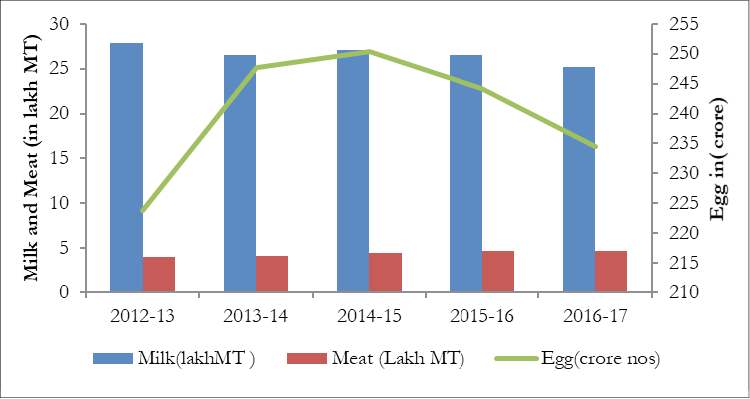
Milk Production
India is the largest milk producing nation in the world. At the national level, milk production has increased steadily over the past three decades. The milk production in India has increased from 155.5 million tonnes in 2015-16 to 163.7 million tonnes in 2016-17, registering a growth of 5.3 per cent. The per capita availability of milk has been increasing in India over the years. It has increased from 337 g per day in 2015-16 to 352 g per day in 2016-17.
Among the milk producing States in the country, Kerala ranks 14th, with a share of just 1.5 per cent of the total milk production in the country. The production of milk has declined from 26.49 lakh MT to 25.20 lakh MT in 2016-17. The per capita availability of milk in Kerala has been declining during the 12th Plan period. It decreased from 200 gm per day in 2015-16 to 189 gm per day in 2016-17 (which is just above half of the national average).
Out of the 25.20 lakh MT of milk produced in the State, majority share is produced by cross bred cows (93.5 per cent). Indigenous cows produce just 1640 MT of milk (0.07 per cent).The production of milk from goat is 1.26 lakh MT (5 per cent). The rest is contributed by ND cattle, indigenous buffalo and ND Buffalo. Details regarding Species wise milk production in Kerala in 2016-17 are provided in Figure 2.11.
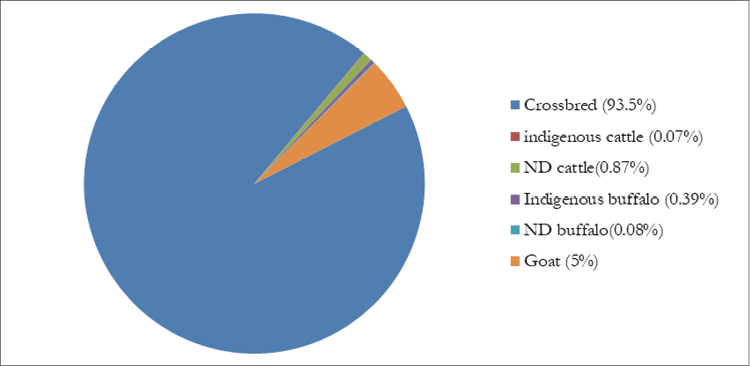
Egg production
At the national level, egg production has increased substantially since 2000-01. Total egg production in India has increased from 82.9 billion numbers in 2015-16 to 88.1 billion numbers in 2016-17, registering a growth of 6.2 per cent. Similarly, there has been a steady increase in per capita availability of egg since 2000-01. It has increased from 66 eggs per annum in 2015-16 to 69 eggs per annum in 2016-17.
The production of egg in Kerala has witnessed drastic changes during the 12th Plan period. The total egg production in the State was at 2.23 billion eggs in the year 2012-13 and then continues to rise over the period and reached at 2.50 billion eggs in the year 2014-15. Since then, it declined to 2.44 billion in 2015-16 and further to 2.34 billion in 2016-17. Kerala ranks 9th among States of India in egg production. Per capita availability of egg had been above the national average during the first four years of the 12th Plan. However it has fallen below the national average in 2016-17. Per capita availability of egg had increased till 2014-15 to reach 70 numbers per annum. It has fallen to 67 in 2015-16 and further to 64 in 2016-17.
About 69 per cent of the total eggs produced in the State is from improved fowl and around 25 per cent is from desi fowl. The contribution of desi duck and improved duck to the total egg production of the State is 2.96 per cent and 2.40 per cent respectively. Details of Species wise poultry production in Kerala are provided in Figure 2.12. Also as much as 99.18 per cent of the eggs produced in the State come from backyard poultry. Commercial poultry contributes only a very miniscule share, warranting emphasis on backyard poultry in coming years.
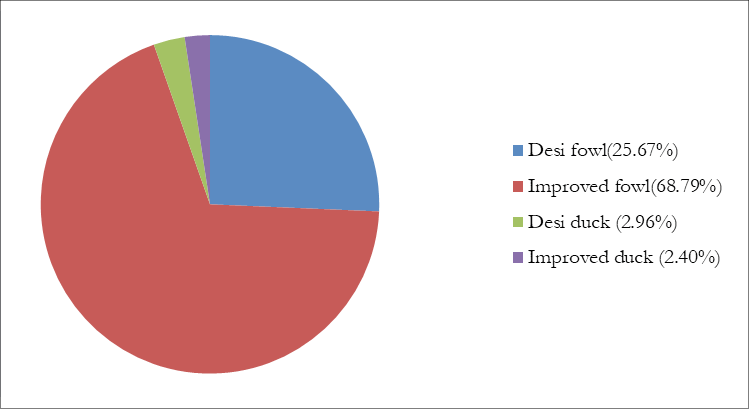
With regard to the share of States in the total egg production, Kerala accounts for just 2.7 per cent of the total egg production while it accounts for 3.3 per cent of the total poultry population. In respect of yield, it is much higher than the national average especially for backyard poultry - for improved fowl it is 220 eggs per year while national average it is 145 eggs per year. Whereas for commercial poultry, with respect to desi duck it is at par with national average, and for improved fowl its much above the national average. Details of backyard poultry in India and Kerala are provided in Figure 2.13.
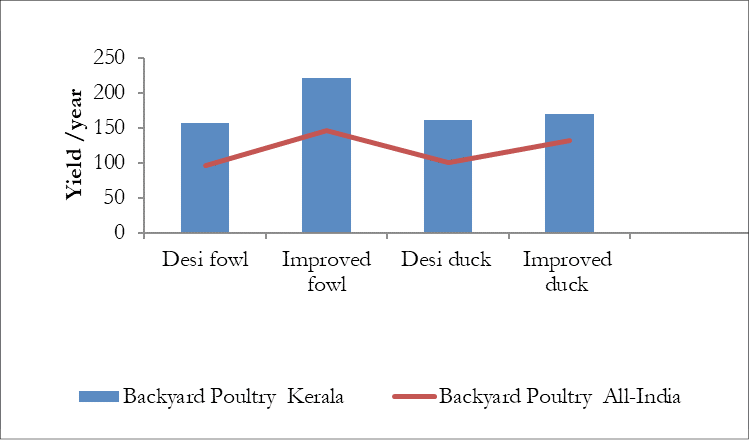
Meat Production
Meat production in India has witnessed a steady increase since 2007-08. The total meat production in the country has increased from 7 million tonnes in 2015-16 to 7.4 million tonnes in the year 2016-17, witnessing a growth rate of 5.71 per cent.
Meat production in Kerala, which was around 2 lakh MT in the beginning of 11th Plan increased to 4.26 lakh MT in 2011-12, but since then it has hovered around 4 lakh MT. In 2016-17 it showed a marginal increase to 4.69 lakh MT from 4.66 lakh MT in 2015-16. Kerala is the 7th largest meat producing State in the country contributing 6.3 per cent of the meat produced in India. Out of the total meat produced, 40.26 per cent is poultry meat, 31.15 per cent is sourced from cattle and 22.6 per cent is from buffalo. Goat and pig contributes just 4.51 per cent and 1.45 per cent of the total meat production in the State. Details of species wise meat production in Kerala is provided in Figure 2.14.
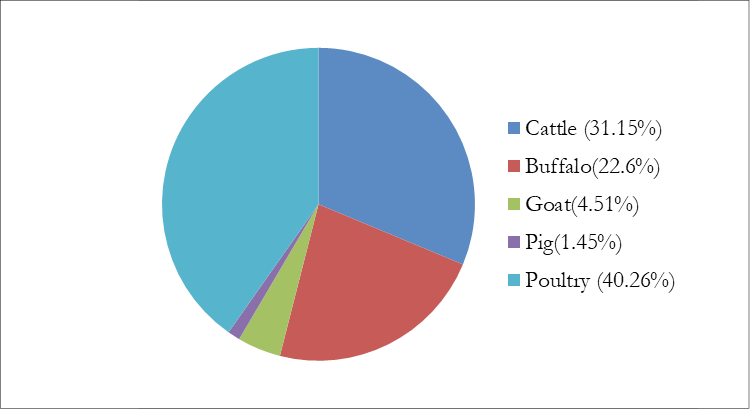
Milk Marketing
Kerala is one of the States, which is giving highest price for milk to the farmers in the country. The demand for milk is increasing day by day and the sale of Milma milk showed improvement in the current year. During 2016-17, a total of 5940 lakh litres of milk was procured by the dairy co-operative societies in the State of which 3779 lakh litres were sent to the dairies and 2161 lakh litres were marketed locally by the societies. The average milk procured per day by APCOS in 2016-17 was 1082 MT against the previous year average of 1109 MT. The procurement/day/society in 2016-17 was 360 litres and during 2015-16 it was 372 litres. The procurement of milk by Kerala Co-operative Milk Marketing Federation (KCMMF) decreased to 3834.58 lakh litres against the sale of 4,774.20 lakh litres during 2016-17. Except in Palakkad and Wayanad, sales of milk exceeded procurement. The shortfall between milk procurement and sales was met by arranging milk mostly from State milk federations of Karnataka, Tamil Nadu, and purchase of skimmed milk powder. Details on procurement and sale of milk by different dairies of KCMMF, performance of KCMMF and milk procured by APCOS are shown in Appendices 2.46, 2.47 and 2.48. The price revision and price spread of milk from 2010 onwards is given in Appendices 2.49 and 2.50 respectively.
Feed and Fodder Base
Special focus has been given to fodder and feed production in Kerala to support the development of the livestock sector considering the wide gap in the availability of these two critical inputs. The Dairy Development Department is the nodal agency for fodder development activities in the State. Under the scheme, production and conservation of fodder in farmer fields and Dairy Co-operatives, a new component commercial and massive fodder production in barren lands and wastelands has been initiated. Those lands which are fertile yet remain under-utilised under the ownership of progressive farmers, other individuals, LSGD, PSU etc. will be selected and intensive fodder cultivation activities will be taken up. In 2016-17, fodder cultivation was taken up for 2050 Ha of land and 3.28 lakh metric ton of additional production was ensured. Besides, assistance has been provided to farmers for Azolla cultivation, mechanisation of fodder cultivation and harvesting, irrigation facilities etc. Innovative fodder development programs under Integrated Dairy Development Program have been implemented in the districts of Kollam and Ernakulam. The total production of cattle feed during 2016-17 was 3.70 lakh metric tonne as against 3.97 lakh MT during 2015-16. The production of feed and fodder are shown in Appendices 2.51, 2.52 and 2.53.
Establishing Distinct Dairy Zones in the State
Under the scheme Commercial Dairy Milk and Milk Shed Development Programme, a new component establishing distinct dairy zones has been initiated. 50 potential Dairy Extension Units coming under 14 Agro Ecological Unit (AEU) are selected for implementation of this programme. The component involves induction of milch cows, heifers, Need based assistance to progressive farmers, assistance for construction of scientific cattle shed, mechanisation of dairy farmers, assistance for purchase of milking machine, silage units, and assistance for stress management to milch animals etc.
Breeding Support
Kerala Livestock Development Board (KLDB) is involved in the production and distribution of frozen semen. Compared to 2015-16, semen production increased from 24.47 lakh doses to 27.66 lakh doses during 2016-17. The distribution inside and outside the State decreased from 17.65 lakh doses to 16.62 lakh doses and 10.71 lakh doses to 4.94 lakh doses respectively during this period. Details are shown in Appendix 2.54.
The number of Artificial Insemination (AI) centres in the State during 2016-17 was 2515. The number of inseminations done during 2016-17 was 12.32 lakh and calving recorded was 3.10 lakh. The average number of inseminations needed for producing one calf is 4. The details of AI are shown in Appendix 2.55. The quality of AI is not improving and so measures to improve the quality of semen supplied needs to be taken up immediately. Activities of the KLD Board are given in Appendix 2.56.
Special Livestock Breeding Programme (SLBP)
The calf rearing programme by subsidising cattle feed for rearing cattle upto 32 months along with health cover and insurance has been under implementation since 1976 onwards. In 2006-07, the scheme was extended to buffalo calves also as a measure to curtail the drastic reduction in the buffalo population. Enrollment of buffalo calves shows a decreasing trend and no buffalo calves were enrolled during the period 2014-15 to 2016-17. In 2016-17, 73,538 calves were enrolled under this programme against 29,164 calves during 2015-16. Year-wise details from 2006-07 onwards are shown in Appendix 2.57.
Animal Health Care
With the improvement in the quality of livestock through cross breeding programs, the susceptibility of various diseases including exotic diseases has increased. The animal husbandry department provides veterinary care mainly through 14 district veterinary centres, 50 veterinary polyclinics, 215 veterinary hospitals, 885 veterinary dispensaries, 38 Regional Animal Husbandry Centres, 1359 Veterinary sub-centres, 9 mobile veterinary hospitals, 7 mobile farm aid units and 1 motorboat veterinary hospital. Effective and timely action was taken by the Animal Husbandry Department in liaison with respective administrations and local self-governments to eradicate contagious diseases. Currently mass campaign vaccination programmes like Foot and Mouth Disease Control Programme, rabies Free Kerala Vaccination Programme and ASCAD Poultry vaccinations are being conducted regularly. Data regarding outbreaks, attacks and deaths of major contagious diseases of animals in Kerala for the period from 2010-11 to 2016-17 are given in Appendix 2.58. Anthrax, Hemorrhagic Septicemia and FMD were reported during 2016-17. Number of attack of Hemorrhagic Septicemia is very high in 2016-17 compared to 2015-16.
Emergency Veterinary Service During Night Hours
The service of a Veterinary doctor is available only in the day time and it is difficult to get the service during odd hours of the day. Hence a project was formulated to provide the expert veterinary care at block level from 6 pm to 6 am. The service of a registered veterinary practitioner is provided on contract basis. The unit is functioning under the direct supervision of one identified veterinary institution of the block area. Medicines are made available to them. Emergency night veterinary service was established in 65 selected blocks of the State up to 2016-17 and in 2017-18 this will be extended to 85 blocks.
Production of Vaccine in Institute of Animal Health and Veterinary Biologicals, Palode
The Institute of Animal Health and Veterinary Biologicals, Palode is the sole agency engaged in the production and distribution of animal vaccine in the State. The production details of vaccines manufactured are shown in Appendix 2.59. During 2016-17, the production of poultry vaccine was 194.95 lakh doses and livestock vaccine was 4.36 lakh doses. Compared to the previous year, production of poultry vaccine decreased by 21.48 per cent and livestock vaccine remains almost the same. Number of vaccinations done during 2016-17 was 26.76 lakh numbers for livestock and 69.52 lakh numbers for poultry. Compared to the previous year, vaccination to cattle increased by 7.47 per cent and vaccination to poultry decreased by 34.64 per cent. Anti Rabies Vaccinations done on dogs decreased from 2.87 lakh numbers to 2.83 lakh numbers in 2016-17. Details are given in Appendix 2.60.
Prices
Average price of important inputs and products of livestock sector for the last six years is presented in Appendix 2.61 and all the products recorded increase in prices during the period. The price of chicken broiler increased by 1.66 per cent, chicken (Desi) by 15.30 per cent, mutton by 7.96 per cent, beef by 8.07 per cent and pork by 2.99 per cent. During 2016-17, the highest increase was in the case of chicken (Desi) (15.30 per cent), followed by beef (8.07 per cent). Compared to 2015-16, the price of fowl-white egg increased by 13.81 per cent, brown egg by 15 per cent and duck egg by 22.31 per cent during 2016-17. Compared to 2015-16, the price of cow milk increased by 7.31 per cent and buffalo milk by 24.38 per cent during 2016-17.
On the input side, the price of straw increased by 13.34 per cent and grass by 5.26 per cent during 2016-17. Compared to the previous year, the price of groundnut cake increased by 10.95 per cent, coconut cake by 9.25 per cent and gingely oil cake by 7.63 per cent during 2016-17 and the increase in the price of inputs is a serious threat to dairy farming and hence the possibility of indigenous source of feeds is to be explored. The trend in average prices of livestock products from 2011-12 to 2016-17 are shown in Figure 2.15.

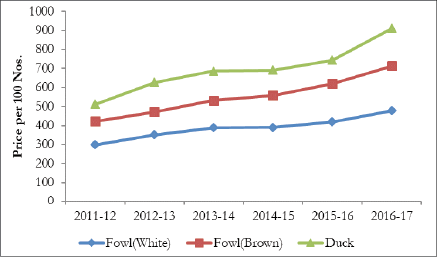
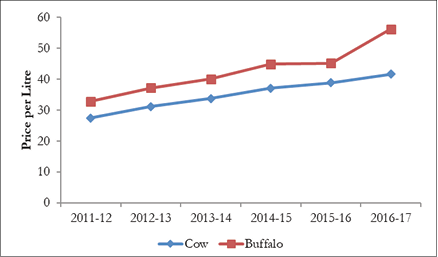
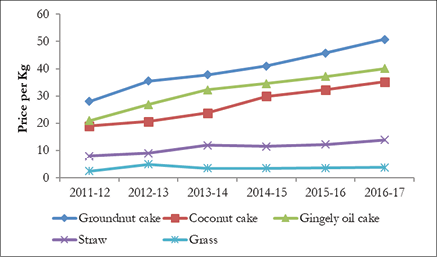 Source: Animal Husbandry Department
Source: Animal Husbandry DepartmentPhysical Achievements in 2016-17
Key Initiatives in 2017-18